Electric charge and electric field
Electric charge
All the materials are made up of atoms. An atom has a central core called, nucleus, which is surrounded by electron (s) moving in orbits. Nucleus is made up of protons and neutrons. Electric charge is a property of electrons and protons. There are two types of charges: positive and negative. An electron has a negative charge and a proton has a positive charge. Neutrons have no charge.
An electron and a proton both have the same amount of charge. The amount of charge an electron or a proton carries is called the elementary charge, $e$, where
$e=1.602\times 10^{-16}C$
coulomb ($C$) is the unit of electric charge.
Since the charge of an electron is negative and that of a proton is positive,
the charge of an electron is $-e$ and the charge of a proton is $+e$.
We use the symbol, $e^-$ to represent an electron and $p^+$ to represent a proton.
Electric charge is quantized and conserved:
Electric charge is quantized in units of $e$, the elementary charge. i.e., you can have charges only in multiples of $e$ but not a fraction of $e$, like money is quantized in units of penny.Further, electric charge is a conserved quantity. i.e., the net electric charge of an isolated system is conserved. So, you cannot create or destroy a net electric charge. You can create one type of charge but the same amount of the other type of charge is automatically created. For example, if you create a charge $q$, then a charge $-q$ is created, which makes the net charge, $q-q=0$.
Objects have equal number of electrons and protons, so the net charge of an ordinary object is zero and the object is neutral. But if an object gains some electrons, then the object has more negative charge than positive charge, and the net charge of the object is negative. And, we say that the object is negatively charged. But if an object loses some electrons, then it will have more positive charge than negative charge, and the net charge of the object is positive. And, we say the object is positively charged.
When you put two charges close to each other, they attract if they are of opposite signs, but they repel if they are of same sign.
Static Electricity
Static electricity refers to the excess charge objects acquire by rubbing. When you rub an object against another object, the objects surfaces get closer and there is a transfer of electrons from one object to the other. Some objects can easily lose electrons, and such an object becomes positively charged by losing the electrons and the other object become negatively charged by acquiring the electrons lost by the other object. Amber, plastic and rubber become negatively charged when rubbed with fur, hair or wool. An object of glass becomes positively charged when rubbed with felt, silk or wool. When you touch a charged object, the charge is neutralized, which results in a static shock.Insulators and Conductors
In conductors, electric charge can move freely from one point to another. Metals are conductors. In a conductor, the outermost electrons of the atoms of the conductor are loosely bound to the nuclei of the atoms. These loosely bound electrons can move freely within the conductor. The loosely bound electrons in a metal are called free electrons or conduction electrons.In insulators, no charge can flow freely because electrons in an insulator are tightly bound to the nuclei of the atoms. Glass and wood are the examples for insulators.
Charging by conduction and induction
Conductors such as metal objects can be charged by conduction or by induction by another charged conductor. In conduction, an object is in direct contact with another object.Charging by conduction
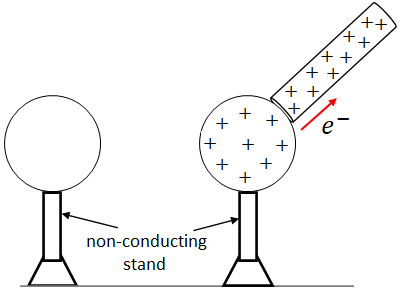
Charging by induction
In induction, the two objects are close to each other but they do not touch. As in the figure below, a negatively charged metal rod is brought near to a neutral conductor (sphere). At the side of the sphere closer to the rod, electrons are pushed away by the negative charge of the rod. So, on the sphere, there is a net positive charge on the side close to the rod and a net negative charge on the side away from the rod. Now, if we ground the sphere, many of the electrons that are pushed away by the rod will move to the ground, leaving the sphere positively charged.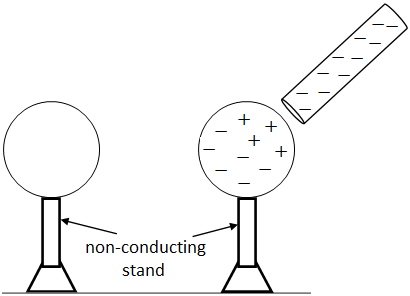
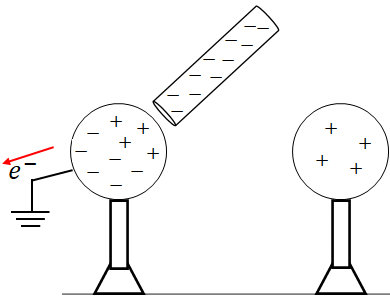
Charge separation in insulators
Nonconductors or insulators cannot be charged by conduction or by induction. But when a charged conductor is brought near to an insulator, the insulator will experience a charge separation. For example, when a positively charged conductor is brought near to an insulator, the electrons of the insulator slightly displace toward the conductor. This is because of the force of attraction between the electrons of the insulator and the positive charge of the conductor.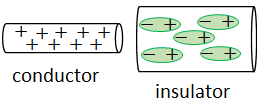
Electroscope
Electroscope is an instrument used to detect charges. It can be used to detect the amount of charge as well as the sign of charges. An electroscope consists of a vertical metal rod with two movable gold leaves at the bottom. At the top of the rod, a metal knob is attached.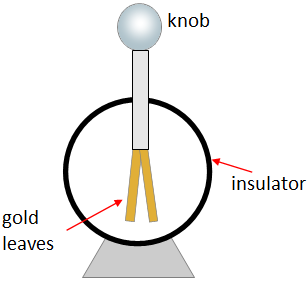
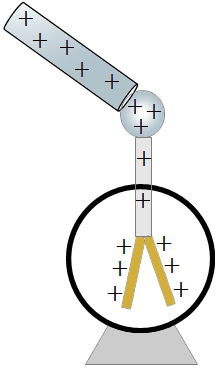
To find the sign of charge of a charged object, first charge the electroscope, say with a positive charge. Now, if you bring a positively charged object near the metal knob of the electroscope, the electrons in the knob will move toward the charged object. So, the leaves become more positively charged, which results in an increase of separation between the leaves. But if you bring a negatively charged object near the knob, all the electrons in the knob will be pushed down leaving less positive charge on the leaves, which decreases the separation between the charges.
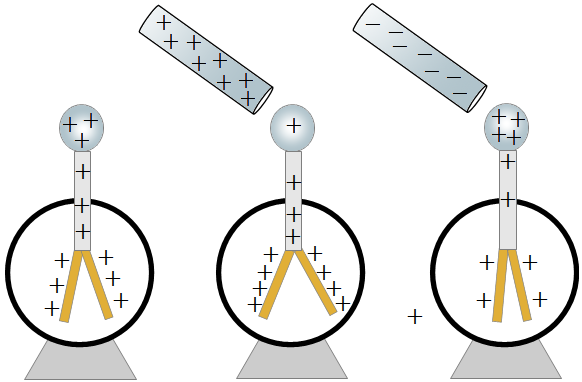
Coulomb's Law
When there are two electric charges, there exists a force between them. The force is attractive if the charges are of opposite signs, and is repulsive if they are of same sign. The force between electric charges is called electric force.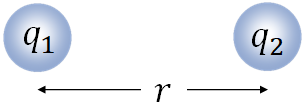
The magnitude of the electric force between two stationary charges is given by
$F=k\dfrac{q_1 q_2}{r^2}$
This is an experimental law, which is called Coulomb's law.
where $q_1$ and $q_2$ are the magnitude of the charges; $r$ is the separation between the two charges and $k=9.0\times 10^9 Nm^2/C^2$ is a constant. The constant $k$ is also written in another form,
$k=\dfrac{1}{4\pi \epsilon_0}$, where $\epsilon_0=8.85\times 10^{-12}C^2/N.m^2.$
$\epsilon_0$ is called the permittivity of free space.
The electric force acts along the line connecting the two charges. As the distance between the charges increases, the electric force between them decreases.Note that, with the Coulomb's law, you can find the magnitude of the force between the two charges. But the direction of the force is determined by the type of the charges.
The charge 1 exerts an electric force on charge 2 and the charge 2 exerts an electric force on charge 1. The two forces are equal in magnitude but in the opposite directions according to Newton's third law. The magnitude of the forces are given by the Coulomb's law. The direction of an electric force depends on the type of the charges. If the charges are of same sign, then the force on charge 1 by charge 2, $\vec F_{12}$ is away from charge 2 as the force is repulsive. And the force on charge 2 by charge 1, $\vec F_{21}$ is away from charge 1.
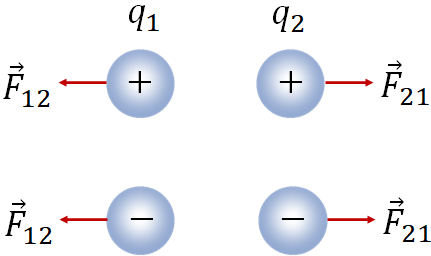
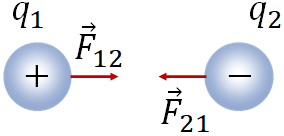
Electric Field
A charge exerts an electric force on another charge without any direct contact. If you have a charge, $Q$ and you put another charge, $q$, in the vicinity of $Q$, then $Q$ exerts a force on $q$. You can think about this in another way that the charge, $Q$ is surrounded by some field and due to that field the charge $q$ experiences an electric force. We call the field surrounding an electric charge, the electric field.We define electric field in terms of electric force. Electric field at a point is defined as the electric force per unit charge, a test charge experiences at that point. So, to find the electric field of a charge, $Q$ at a point from it, assume a test charge, $q$ is at the point of interest, and find the force on the test charge, then divide that force by $q$. That is the electric field, $\vec E$ of the charge $Q$ at a point $P$ is
$\vec E=\dfrac{\vec F}{q}$
where $\vec F$ is the force on the test charge at $P$.
The magnitude of the force on the test charge according to Coulomb's law is
$F=k\dfrac{Q q}{r^2}$
where $r$ is distance between the charge $Q$ and the point $P$, which is the distance of the point from the charge, $Q$.
Therefore the magnitude of the electric field is$E=\dfrac{F}{q}=k\dfrac{Q q}{r^2}/q$
or$E=k\dfrac{Q}{r^2}$
This is the equation for the magnitude of electric field at a distance $r$ from any charge $Q$. Since it is for the magnitude, you should not put the sign of the charge in the equation.Electric field is a vector as it is a force per unit charge. So, it has a direction. What is the direction of the electric field?, which you will see in the next section.
From the definition of the electric field, we can write
$\vec F=q\vec E$
where $\vec F$ is the force the electric charge, $q$ experiences in an electric field, $\vec E$.
From this equation, you see that when $q$ is positive, the force and the electric field are in the same direction, and if $q$ is negative, then the force and the electric field are in the opposite directions. That is, the force on a positive charge in an electric field is in the direction of the electric field, and the force on a negative charge in an electric field is in the direction opposite to the direction of the electric field.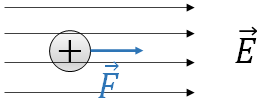
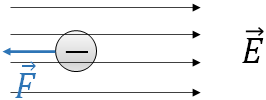
So, if you put a positive charge in an electric field, it will move in the direction of the electric field, but a negative charge will move in the opposite direction to the electric field.
Electric Field Lines
You learned, an electric charge is surrounded by electric field. And, we have an equation to find the electric field at a point from any charge. Now, the question is, what is the direction of the electric field. The direction of the electric field at a point from a charge depends on the sign of the charge as you will see below.First let us consider we have a positive charge, $Q$. We are going to find the direction of the electric field at a point $P$ from this charge. Let us assume that there is a positive test charge $q$ at the point $P$. Due to the electric field, $\vec E$ of the charge, $Q$ at P, there is a force, $\vec F$ exerts on the charge $q$. Since the two charges, $Q$ and $q$ are positive, the force on $q$ is away from the charge $Q$. Further, since the charge $q$ is positive, the electric field and the force are in the same direction. Therefore, the direction of the electric field at the point $P$ is away from the charge $Q$. Like these, we can find the electric field at any point surrounding the electric charge $Q$. And at any point around the charge, the electric field points away from the charge. So, the electric field of a positive charge points away from the charge at any location around the charge as in the figure below.
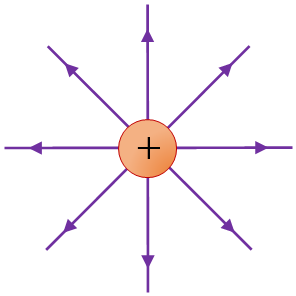
Now, if the charge $Q$ is negative, then the force on $q$ will be toward the charge $Q$. Since the force and the electric field are in the same direction (as $q$ is positive), the electric field is now towards the charge $Q$. So at any point around a negative charge, the electric field is toward the charge.
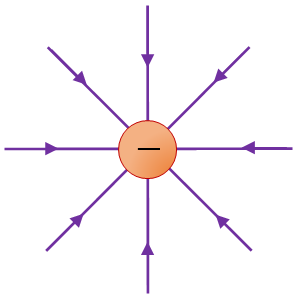
Electric field is represented by lines with arrows, called electric field lines. The arrow of a field line indicate the direction of the electric field at a given location. Since the electric field of a positive charge is directed away from the charge and that of a negative charge is toward the charge, the electric field lines start at positive charges and end at negative charges. The number of field lines starting on a positive charge or ending on a negative charge is proportional to the magnitude of the charge. Further, the electric field is stronger where the field lines are closer together. Note that the field lines are just a representation to show the direction of the electric field and also how strong the field is at a given location.
In the figure below, the magnitude of the positive charge on the left is twice as that of the charge on the right as there are twice as many lines from the charge on the left as compared to the lines that end at the negative charge on the right. Also, you see that the electric field lines are closer together near the charges where the electric field is stronger.
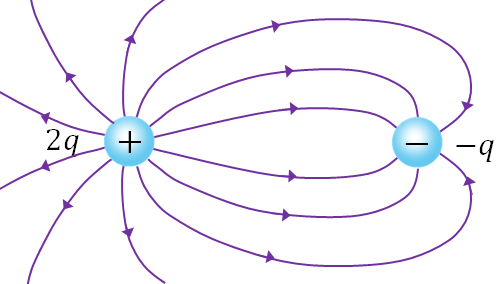
The electric field distribution of two negative charges of same magnitude is shown below.
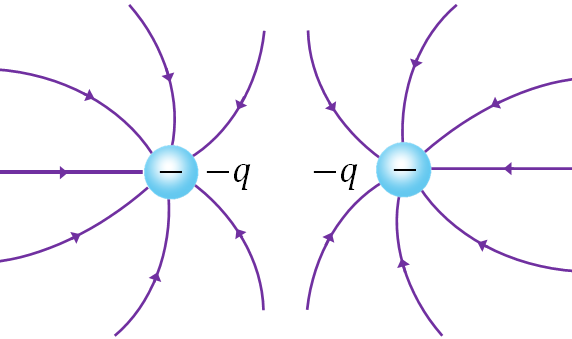
Electric Fields and Conductors
Electrostatic condition refers to the state of a conductor where there is no motion of charge. Under electrostatic condition, electric field inside a conductor is zero and also the electric field is perpendicular to the surface outside of the conductor. If the electric field is not zero inside the conductor, the charge would move due to the electric force of the field. And if the electric field is not perpendicular to the surface, then there will be a component of the electric field parallel to the conductor that would make the charge move.If you put some charge on a conductor, the charges distribute on the surface of the conductor as they want to stay away from each other due to the repulsive force between them. So, any net charge on a conductor resides on the surface of the conductor.
Electric flux and Gauss's law
Electric flux
Electric flux is a concept that is very useful in solving problems involving electric field.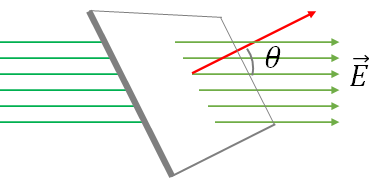
Electric flux through an area is defined as the product of the electric field and the projected area of the surface on to a plane that is perpendicular to the electric field.
i.e., Electric flux through a surface of area, $A$ is defined as
$\Phi_E=EA\cos\theta$
where $\theta$ is the angle between the electric field direction and a line drawn perpendicular to the surface. This equation can also be written as,$\Phi_E=E_\perp A$
where $E_\perp=E\cos\theta$ is the component of the electric field perpendicular to the surface. Electric flux through an area is proportional to the total number of field lines crossing the area. If the electric field is perpendicular to the surface, then $\theta=0$.To find the total or net electric flux through a closed surface, you need to find the flux through each surface and add them. For example, if you have a closed surface in the shape of a cube, and want to find the net flux through the cube, find the flux through all the 6 sides of the cube separately and add them.
Gauss's law
Gauss's law relates the total electric flux through a closed surface to the charge enclosed by that surface. It states that net electric flux through a closed surface is the total charge enclosed by the surface divided by $\epsilon_0$.i.e., total electric flux through a closed surface is
$\Phi_E=\dfrac{Q}{\epsilon_0}$
where $Q$ is the total charge enclosed by the surface. Note that the net electric flux is the same whether the closed surface is small or big as the net flux is determined only by the charge enclosed.Gauss's law can be used to find the electric field in situations with a high degree of symmetry. i.e., the surfaces on which electric field is constant. You will see some of the applications of Gauss's law below.
Electric field in a charged spherical conducting shell
By using Gauss's law, we can find the electric field inside and outside of a charged spherical shell. Consider a charged spherical shell of radius $R$ that has a total net charge, $q$, uniformly distributed on it.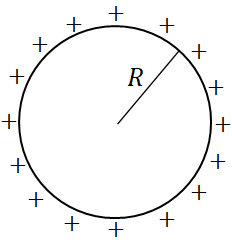
First we will find, what is the electric field inside the shell. We need an enclosed surface to apply Gauss's law. So, imagine a spherical surface inside the shell of radius $r$ with the same center as the spherical shell, where $r < R$, we call this surface, Gaussian surface.
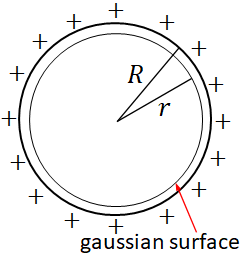
Applying the Gauss's law for the Gaussian surface, we have
$EA \cos\theta=Q=0$
or$E=0$
i.e., the electric field inside a spherical shell is zero.To find the electric field outside the spherical shell, we draw a spherical surface of radius $r$ ($r>R$) outside of it with the same center as the shell. Now, if you take any point on this imaginary surface (Gaussian surface), you see that the charges on the spherical shell are symmetrically distributed for all the points, so the electric field should be the same. Also, since the electric field of a conductor is perpendicular to the surface, electric field is perpendicular to the Gaussian surface at all points. So, the angle $\theta=0$. Therefore, the flux through the surface is $\Phi_E=EA\,cos(0)=EA$. Since the surface is outside the shell, the enclosed charge of the Gaussian surface is just the charge of the shell, therefore, $Q=q$. Now, applying Gauss's law we get,
$EA=\dfrac{q}{\epsilon_0}$
Solving for $E$, we get
$E=\dfrac{q}{A\epsilon_0}$
Since the gaussian surface is a spherical surface, its area is $A=4\pi r^2$, substituting this, we get
$E=k\dfrac{q}{r^2}$
This is the electric field at any point outside the shell that is at a distance, $r$ from the center of the spherical shell. This is similar to the electric field at a distance $r$ from a point charge.Electric field near a conducting surface
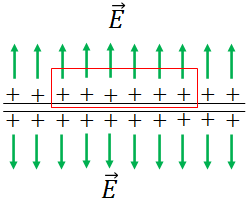
To find the electric field at a point near the conductor, we choose a Gaussian surface of a box shape. The top surface of the box is outside the sheet and the bottom side is within the sheet. So, the box encloses the top surface of the sheet as shown in the figure. Now, if you look at the electric field through the Gaussian surface (the box), the electric field is perpendicular to the top surface, and is parallel to the left and the right sides and there is no electric field through the bottom surface as it is within the sheet and the electric field within a conductor is zero. So, the net electric flux through the Gaussian surface is just the flux through the top surface. If we take $A$ as the area of the top surface, then the flux through the top surface of the box is $EA$. This is the net flux through the Gaussian surface, i.e., $\Phi_E=EA$. The charge, $Q$ enclosed by the Gaussian surface is the charge on the top surface of the sheet that is within the Gaussian surface (the box). Now, applying Gauss's law,
$EA=\dfrac{Q}{\epsilon_0}$
(or)$E=\dfrac{(Q/A)}{\epsilon_0}$
Since $Q$ is the charge on the area $A$, $Q/A$ is just the surface charge density of the sheet. Therefore, we have$E=\dfrac{\sigma}{\epsilon_0}$
This is the electric field near a charged conducting sheet. Although we took an infinite conducting sheet, this equation is applicable to any conducting sheet of finite size, if we do not consider the field near the edges.Electric field between parallel plates
In the figure below, there are two charged plates of same area separated by some distance. Both the plates have same amount of charge, $Q$ but of opposite signs. Since the plates are conducting, electric field is perpendicular to the plates and the field lines start with the positive plate and end with the negative plate.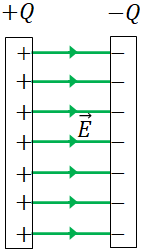
$E=\dfrac{\sigma}{\epsilon_0}$
where $\sigma=\dfrac{Q}{A}$, $Q$ is the charge on one of the plates and $A$ is the area of one of the plates. $\sigma$ is the surface charge density of the plates.
Direction of the electric field is from the positive to the negative plate.
